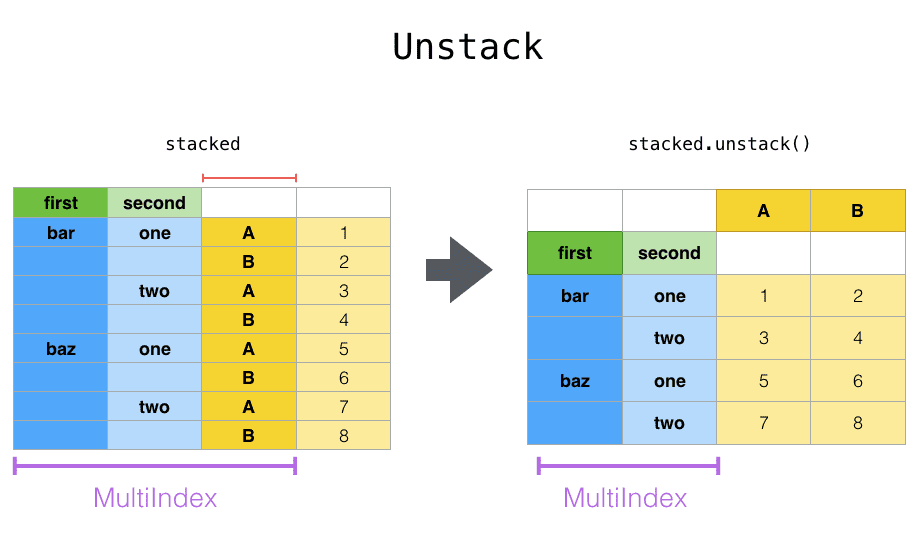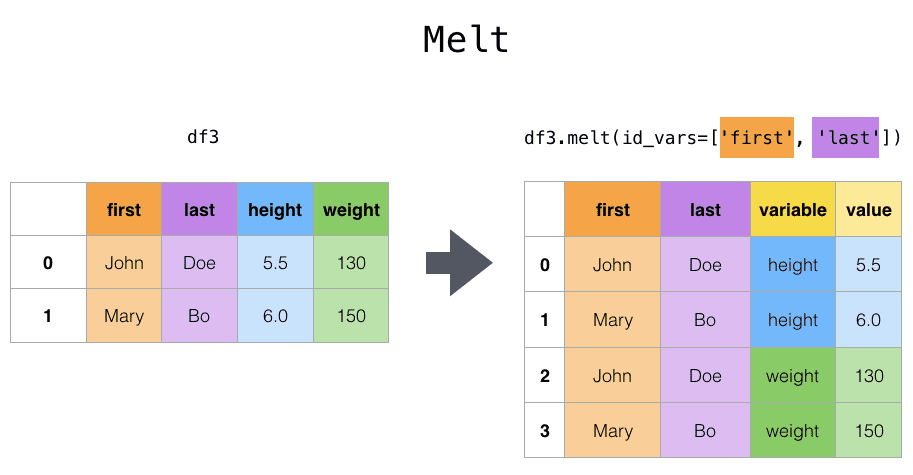pandas melt что делает
Pandas elt () и нерясь с помощью функции pivot ()
Функция Pandas Melt () используется для изменения формата DataFrame из шириной до длительного времени. Он используется для создания определенного формата объекта DataFrame, где один
Функция Pandas Melt () используется для изменения формата DataFrame из шириной до длительного времени. Он используется для создания определенного формата объекта DataFrame, в котором один или несколько столбцов работают как идентификаторы. Все оставшиеся столбцы рассматриваются как значения и необотаются на ось строки и только два столбца – Переменная и ценность Отказ
1. Pandas Melt () Пример
Использование функции MELT () более ясна при просмотре примера.
Мы можем передавать параметры «var_name» и «value_name», чтобы изменить имена столбцов «Переменную» и «значение».
2. Несколько колонн как id_vars
Посмотрим, что произойдет, когда мы передаем несколько столбцов в качестве параметра ID_VARS.
3. Пропуск колонн в функции MELT ()
Не требуется использовать все строки из источника DataFrame. Давайте пропустим столбец «ID» в следующем примере.
4. Невозможное значение dataframe с использованием функции pivot ()
Мы можем использовать функцию Pivot (), чтобы нерешить объект DataFrame и получить исходное dataframe. Значение параметра функции Pivot () () должно быть таким же, как значение «id_vars». Значение «столбцов» следует пропущено как имя столбца «Переменная».
Неожиданные значения DataFrame такие же, как исходное dataframe. Но столбцы и индекс нуждаются в незначительных изменениях, чтобы сделать его точно так же, как оригинальный кадр данных.
Unpivot Your Data with the Pandas Melt Function
In this post, you’ll learn how to use the Pandas melt function.
The melt function is used to reshape a Pandas from wide to long format. What this means is that one or more columns are used as identifiers and all other columns are used as values.
Why Use Pandas Melt to Unpivot Data?
This is helpful if you’re given data in a wide format, such as report you find online or you may have been given by a colleague. This data is easy to understand, but it’s harder to reshape into some other form of analysis.
Loading a Sample Dataframe
Let’s begin by loading a sample dataframe in wide-format.:
This generates our dataset in a wide-format. The printout shows:
What is the Pandas Melt Syntax?
The general format for the melt function looks like this:
Let’s take a look at all of these in a bit more detail:
How to Unpivot Your Data Using the Pandas Melt Function
Let’s take a look at how we can use the Pandas melt function to unpivot the dataset.
From what we learned earlier, we need to reassign the dataframe:
Notice that we didn’t include the value_vars. Since we wanted to unpivot all of our data, Pandas was able to assign all the columns.
This is the same as writing:
Both of these return the following output:
Conclusion
Using just a few steps in Python, we were able to unpivot data using Pandas and the melt function to transform a cross-tab style, wide dataset into one that’s become much more useful for further analysis.
Find out more about the melt function by checking out its official documentation.
Check our our eBook to get started with Python for Data Science!
Pandas melt что делает
При работе с таблицами Pandas порой приходится их видоизменять, в частности, когда таблица многоуровневая. В этой статье мы расскажем вам об основных функциях Pandas для изменения формы таблицы. К этим функциям относятся: pivot для создания сводной таблицы, stack/unstack для добавления/удаления уровня и melt для преобразования столбцов в строки.
Сводные таблицы с Pivot

Пример с кодом на Python для создания сводной таблицы:
Добавляем и удаляем уровни
С pivot тесно связаны связанные методы stack и unstack как для объектов Series, так и DataFrame. Эти методы предназначены для совместной работы с многоуровневыми таблицами. Под уровнем подразумевается столбец в индексе. Вот что в сущности делают эти методы:

Код на Python для добавления уровня в таблице Pandas:
Из столбцов в переменные

Следующий пример на Python демонстрирует результат Pandas-функции melt:
Еще больше подробностей о преобразовании таблиц Pandas в рамках анализа данных и задач Data Science на реальных примерах вы узнаете на нашем специализированном курсе «DPREP: Подготовка данных для Data Mining на Python» в лицензированном учебном центре обучения и повышения квалификации IT-специалистов в Москве.
Data Independent 
Learning Data Analysis One CSV At A Time
Pandas Melt – pd.melt()
Pandas Melt is not only one of my favorite function names (makes me think of face melting in India Jones – gross clip), but it’s also a crucial data analysis tool.
Pandas pd.melt() will simply turn a wide table, tall. This will ‘unpivot’ your data so column(s) get enumerated into rows.
I use this function I want to turn pretty data thats easy to read (many columns) into usable data (many rows) that is easier to analyze.
In the above scenario, having two columns for dates (8/6 & 8/7) looks good, but it’s harder to do analysis on. I want turn those columns into row permutations.
Pseudo code: Take a column or columns, and transpose them into rows. “Unpivot” your data.
Pandas Melt
Pandas Melt is a function you’ll use when deciding the architecture of your of your data sets. This will ultimately lead to how you think about your analysis and questions you want to answer.
Melt Parameters
Here’s a Jupyter notebook showing how to Melt in Pandas
Pandas melt что делает
Jun 17, 2018 · 6 min read
Reshaping Pandas Data frames with Melt & Pivot
Pandas is a wonderful data manipulation library in python. Working in the field of Data science and Machine learning, I find myself using Pandas pretty much everyday. It’s an invaluable tool for data analysis and manipulation.
In this short article, I will show you what Melt and Reverse melt (Unmelt) are in Pandas, and how you can use them for reshaping data frames.
Say, I have the data of the closing prices of stock market data of stock market closing prices of two major companies for last week as follows:
For an ana l ysis I want to do I need the names of the companies Google & Apple to appear in a single column with the stock price as another column, as shown below.
This is exactly where melt comes into picture. Melt is used for converting a bunch of columns into a single row, which is exactly what I need here.
Let’s see how we can do this:
First we need to import pandas
import pandas as pd
Now, we’ll create the Dataframe with the data I need:
And this will get us the dataframe we need as follows:
Let’s melt this now. To melt this dataframe, you call the melt() on the dataframe with the id_vars parameter set.
And you’re done. Your reshaped_df would like this now:
Unmelt/Reverse Melt/Pivot
Running the above command gives you the following:
This is close but probably not exactly what you wanted. The Closing Price is an extra stacked column on top of Google & Apple. So to get exactly the reverse of melt and get the original df dataframe we started with, we do the following:
And that gets us back to what we have started with.
That is all for this article. I hope this was useful for you and that you’ll try to use this in your data processing workflow.
For more programming articles, checkout Freblogg
Some python articles that you might find useful:






